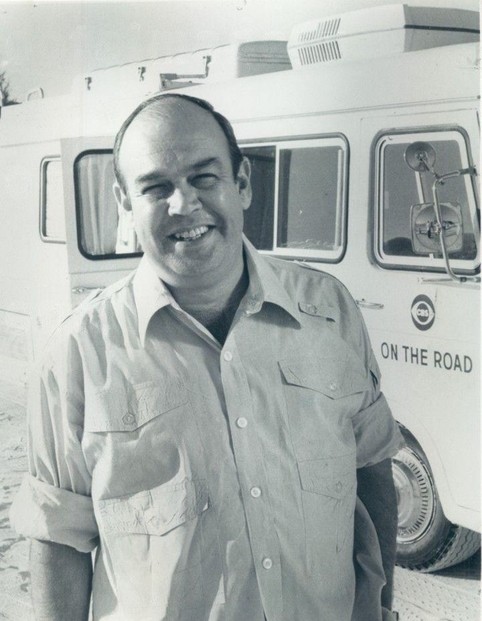Rumpled, balding, and of generous dimensions, Charles Kuralt had a rich, melodious voice. It was the kind that turned would-be broadcast journalists green with envy. His writing style was folksy, and his reports were delivered in a slow, engaging way. Behind the avuncular persona, Kuralt had two families, one in New York and the other in Montana.

The Double Life of Charles Kuralt
by RupertTaylor
The beloved CBS correspondent had a relationship that was kept a secret until he died.
 Charles Kuralt in 1976 https://en.wikipedia.org/wiki/Charles_Kuralt#/media/File:Charles_Kuralt_1976_CBS_publicity.jpg |
Calm Amid the Chaos
Between 1967 and the mid-1990s, Kuralt filed more than 600 pieces for his On the Road segment on the CBS Evening News.
Served up in the midst of the violence, scandals, and mayhem that filled the typical newscast, Kuralt delivered what Time Magazine called his “Two-minute cease-fires.”
Famed anchorman Walter Kronkite once said, “I objected to doing the On the Road pieces at first ... but with the very first piece he did, I was convinced that we better get them on the air.”
And, for all the years he was filing his feel-good stories, Charles Kuralt was leading a secret double life.
Charles Kuralt's Calming Salves
Veteran CBS reporter Charles Kuralt covered the Vietnam War and various other hostilities but is best remembered for his short sketches of oddball American life.
The series started in a time of turmoil. Protests against the Vietnam War were roiling America. It was the “Summer of Love” and race riots in Detroit, Buffalo, Boston, Atlanta, and many other cities.
Charles Kuralt went to the CBS brass and pitched the idea of human-interest stories from the back roads of the country. Later, he would say the subjects of his short essays “... are people you know, not from the front pages. They’ve never been on the front pages. They’re people you know from next door and down the block.”
CBS bought the idea and equipped Kuralt with a motor home and a small crew. He headed off into the countryside saying, “Interstate highways allow you to drive coast to coast, without seeing anything.”
His first story was so simple―children in New England romping about in autumn leaves―but it nearly jammed the switchboard at CBS. Viewers wanted relief from the bloody conflicts; they wanted more Charles Kuralt.
A Review of Kuralt's Broadcasting Career
The Traveling Man
In a modest camper, Kuralt traveled through all 50 states looking for offbeat stories with which he could engage viewers. He rarely reported from cities; it was in rural areas and small towns that he found his subjects.
Kuralt’s television vignettes were filled with folks, not people, folks. His subjects wore overalls, not suits. If someone was baking a pie it wasn’t apple, it was huckleberry.
In Prairie, Mississippi he found the Chandler family celebrating Thanksgiving. Alex and Mary were poverty-stricken sharecroppers who raised nine children and sent them all to college. The kids and the kid's kids gathered to celebrate the Chandlers' golden wedding anniversary.
Kuralt Discoveries
In Boonville, California (population 1,020) Kuralt found people speaking a language he could not understand; it was called “Bootling” and it was mischievously invented by the locals to confuse strangers. It confused the reporter.
And, in Berkeley, California he came across Joseph Charles who made his retirement project waving to passers-by in their cars.
He talked to a man who had written down the name of every person he had met during his life. “Did you meet anyone famous?” asked Kuralt. The man turned the pages of his book to where he had written “Jesus Christ.”
There were horse traders, a Kentucky hillbilly who became a top-quality croquet player, a Texas barber who moonlighted across the border in Mexico as a bullfighter. He visited small towns that held quirky festivals featuring turkey races, or filling potholes.
Near Amarillo, Texas he called in on farmer Stanley Marsh III who had planted ten Cadillacs “nose down in a wheat field.” Roadside America notes that Marsh "... wanted a piece of public art that would baffle the locals, and the hippies came up with a tribute to the evolution of the Cadillac tail fin."
 In April 1975, Charles Kuralt famously visited Cadillac Ranch, an art installation featuring numerous buried Cadillacs. |
A Different Kind of Journalism
His stories were always upbeat, and he took a lot of flak from more hard-nosed journalists for being “sappy.”
In spite of all the evidence to the contrary in the news, he thought people are good. And, that’s what comes through in all his writing. “You learn that the country isn’t in flames,” he said. “I think it’s nice to be reminded of that.”
He added, “There are sights in this country and people in this country to banish any gloom you ever may feel and to fill you instead with wonder.”
The people he covered were universally modest and self-effacing. Kuralt’s longtime cameraman, Isadore Bleckman, once said, “They didn’t know there was anything special about themselves until Charles held up a mirror to them.”
Here’s how Seth Stevenson (Slate) describes the characters that gave Kuralt’s stories their life: “They’re odd people, doing oddly beautiful things, tucked away in odd corners of the country.”
One wonders what Kuralt would have to say about the toxicity of Trump's America.
What About the Double Life?
Oh right.
After Kuralt died in 1997 at the age of 62, Mrs. Charles Kuralt in New York City was shocked to discover that her husband had another family in Montana.
For 30 years, Patricia Elizabeth Shannon was his mistress, and he was father to her children from a previous marriage, paying for college and law school tuition.
He spent a few days with her every month or so and eventually she settled in a home he had built in Montana overlooking the Big Hole River. His traveling schedule made absences away from his wife in New York easy to explain.
Kuralt was a generous lover. By Ms. Shannon’s estimate, he gave her $600,000 during the first decade of their relationship.
He was making $6 million a year, so financing two families was not a problem. But, if the real Mrs. Kuralt had ever seen his checkbook she might have been suspicious about some large withdrawals from his account.
The truth of his double life came out after his death when Patricia Shannon made a claim on the Montana property. Litigation followed and eventually Ms. Shannon was granted the land and house.
The double life of the man who cheated on his wife seemed so at odds with the people he paid tribute to in his On the Road yarns. They were people of character, virtue, and goodness.
Perhaps, Charles Kuralt’s secret life was the best story he never told.
Bonus Factoids
- During the course of Kuralt’s On the Road series, he wore out six recreational vehicles.
- Thomas Steinbeck is the son of Nobel Prize-winning writer John Steinbeck. He says the inspiration for On the Road came from his father’s book Travels with Charley, in which he chronicles a 1960 trip through America in a camper van with his pet standard poodle.
- Charles Kuralt had this advice for travelers: “If staying in a motel do not sleep on the side of the bed nearest the telephone because that’s where corn-fed salesmen sit when making their calls.”
Sourcs
- “Cameraman Went ‘On the Road with Charles Kuralt.’ ” Scott Simon, NPR, December 19, 2009.
- “On the Road Again.” Seth Stevenson, Slate, October 2009.
- “A Double Life on the Road.” Paige Williams, Washington Post, June 1, 1998.
- And the writer's failing memory.
© Copyright Rupert Taylor 2017.
You might also like
Why Hermione Granger Would Make the Perfect Beauty in Guillerm...Find out what Beauty and Hermione Granger have in common, and learn what to e...
Walt Disney: when dreams come trueAmazing facts about Walt Disney, animator, producer, actor, businessman and a...



 The Legend of Gustave the Man-Eating Crocodile1 day ago
The Legend of Gustave the Man-Eating Crocodile1 day ago
 American Cop Shakedownon 09/16/2014
American Cop Shakedownon 09/16/2014
 How Stores Manipulate Customerson 07/16/2014
How Stores Manipulate Customerson 07/16/2014
 Corruption in Russiaon 06/27/2014
Corruption in Russiaon 06/27/2014


Comments